第4章 英汉语言对比与翻译(总结)
- 格式:ppt
- 大小:3.55 MB
- 文档页数:39
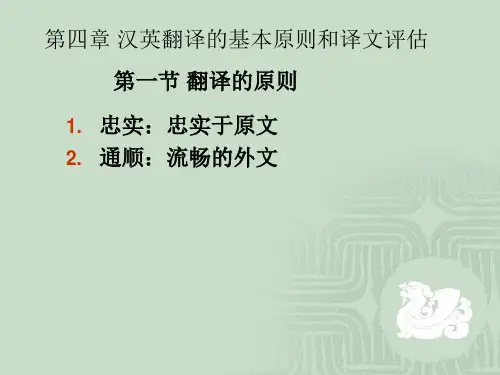

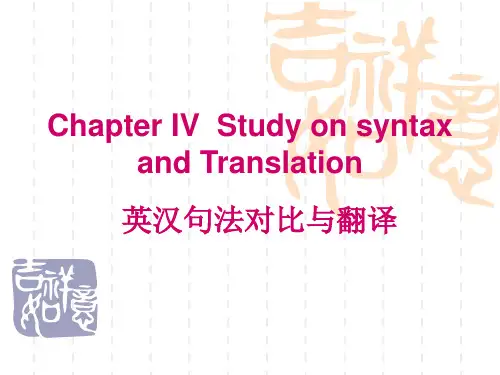
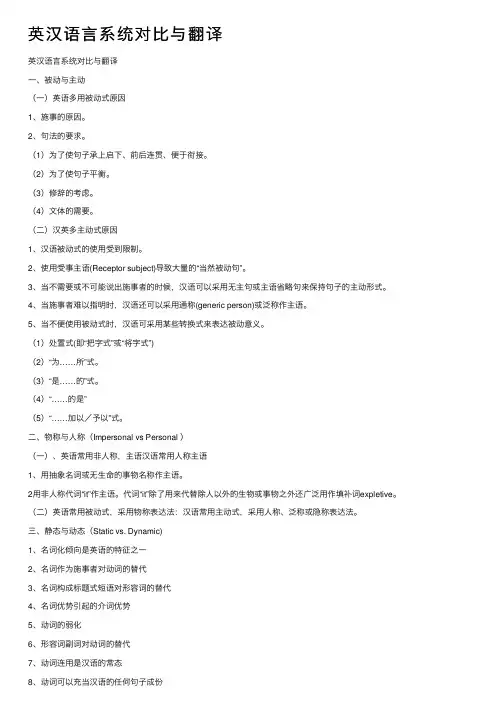
英汉语⾔系统对⽐与翻译英汉语⾔系统对⽐与翻译⼀、被动与主动(⼀)英语多⽤被动式原因1、施事的原因。
2、句法的要求。
(1)为了使句⼦承上启下、前后连贯、便于衔接。
(2)为了使句⼦平衡。
(3)修辞的考虑。
(4)⽂体的需要。
(⼆)汉英多主动式原因1、汉语被动式的使⽤受到限制。
2、使⽤受事主语(Receptor subject)导致⼤量的“当然被动句”。
3、当不需要或不可能说出施事者的时候,汉语可以采⽤⽆主句或主语省略句来保持句⼦的主动形式。
4、当施事者难以指明时,汉语还可以采⽤通称(generic person)或泛称作主语。
5、当不便使⽤被动式时,汉语可采⽤某些转换式来表达被动意义。
(1)处置式(即“把字式”或“将字式”)(2)“为……所”式。
(3)“是……的”式。
(4)“……的是”(5)“……加以/予以”式。
⼆、物称与⼈称(Impersonal vs Personal )(⼀)、英语常⽤⾮⼈称,主语汉语常⽤⼈称主语1、⽤抽象名词或⽆⽣命的事物名称作主语。
2⽤⾮⼈称代词“it”作主语。
代词“it”除了⽤来代替除⼈以外的⽣物或事物之外还⼴泛⽤作填补词expletive。
(⼆)英语常⽤被动式,采⽤物称表达法:汉语常⽤主动式,采⽤⼈称、泛称或隐称表达法。
三、静态与动态(Static vs. Dynamic)1、名词化倾向是英语的特征之⼀2、名词作为施事者对动词的替代3、名词构成标题式短语对形容词的替代4、名词优势引起的介词优势5、动词的弱化6、形容词副词对动词的替代7、动词连⽤是汉语的常态8、动词可以充当汉语的任何句⼦成份9、汉语句⼦中的动词可重复重叠⼀、被动与主动(Passive vs.Active) 被动语态在英语⾥是⼀种常见的语法现象。
在某些⽂体中,使⽤被动句⼏乎成了⼀种表达习惯。
Baker 指出:“被动句促成了物称倾向,物称倾向也滋长了被动句”。
(⼀)英语多⽤被动式原因1、施事的原因。
⼈们表达思想的时候,通常使⽤主动句。

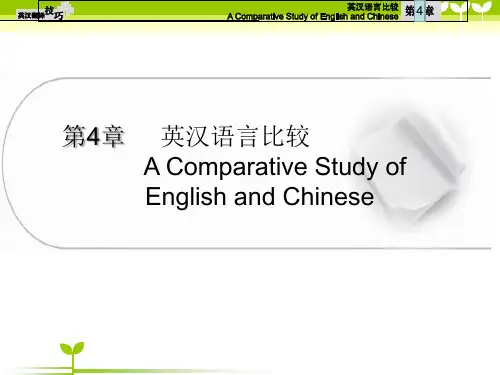
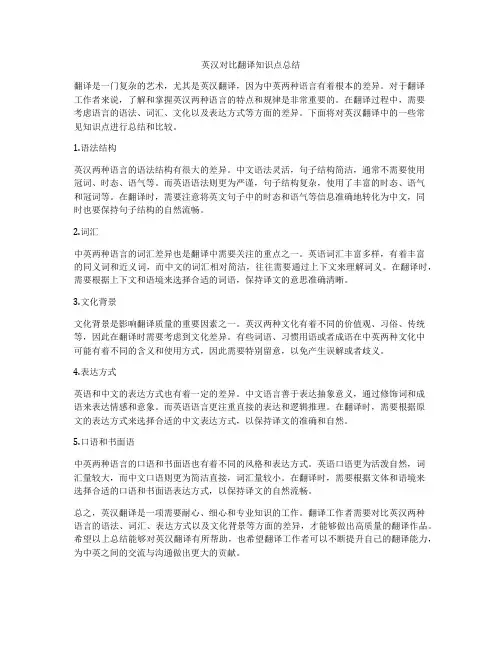
英汉对比翻译知识点总结翻译是一门复杂的艺术,尤其是英汉翻译,因为中英两种语言有着根本的差异。
对于翻译工作者来说,了解和掌握英汉两种语言的特点和规律是非常重要的。
在翻译过程中,需要考虑语言的语法、词汇、文化以及表达方式等方面的差异。
下面将对英汉翻译中的一些常见知识点进行总结和比较。
1.语法结构英汉两种语言的语法结构有很大的差异。
中文语法灵活,句子结构简洁,通常不需要使用冠词、时态、语气等。
而英语语法则更为严谨,句子结构复杂,使用了丰富的时态、语气和冠词等。
在翻译时,需要注意将英文句子中的时态和语气等信息准确地转化为中文,同时也要保持句子结构的自然流畅。
2.词汇中英两种语言的词汇差异也是翻译中需要关注的重点之一。
英语词汇丰富多样,有着丰富的同义词和近义词,而中文的词汇相对简洁,往往需要通过上下文来理解词义。
在翻译时,需要根据上下文和语境来选择合适的词语,保持译文的意思准确清晰。
3.文化背景文化背景是影响翻译质量的重要因素之一。
英汉两种文化有着不同的价值观、习俗、传统等,因此在翻译时需要考虑到文化差异。
有些词语、习惯用语或者成语在中英两种文化中可能有着不同的含义和使用方式,因此需要特别留意,以免产生误解或者歧义。
4.表达方式英语和中文的表达方式也有着一定的差异。
中文语言善于表达抽象意义,通过修饰词和成语来表达情感和意象。
而英语语言更注重直接的表达和逻辑推理。
在翻译时,需要根据原文的表达方式来选择合适的中文表达方式,以保持译文的准确和自然。
5.口语和书面语中英两种语言的口语和书面语也有着不同的风格和表达方式。
英语口语更为活泼自然,词汇量较大,而中文口语则更为简洁直接,词汇量较小。
在翻译时,需要根据文体和语境来选择合适的口语和书面语表达方式,以保持译文的自然流畅。
总之,英汉翻译是一项需要耐心、细心和专业知识的工作。
翻译工作者需要对比英汉两种语言的语法、词汇、表达方式以及文化背景等方面的差异,才能够做出高质量的翻译作品。
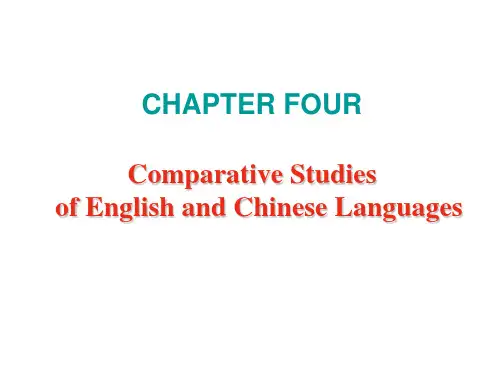
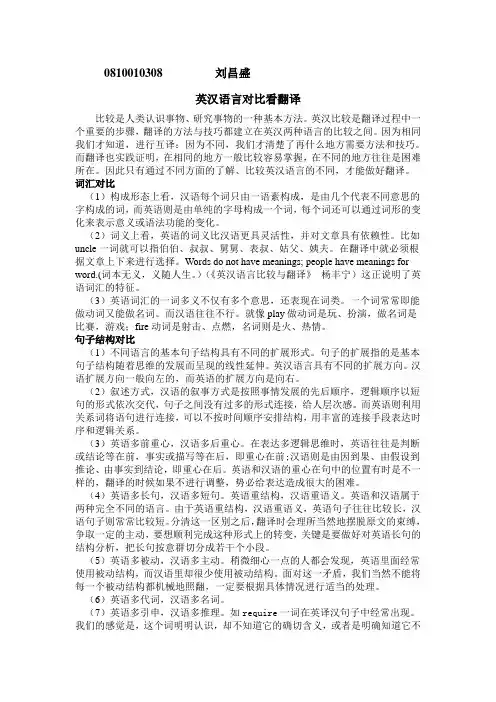
0810010308 刘昌盛英汉语言对比看翻译比较是人类认识事物、研究事物的一种基本方法。
英汉比较是翻译过程中一个重要的步骤,翻译的方法与技巧都建立在英汉两种语言的比较之间。
因为相同我们才知道,进行互译;因为不同,我们才清楚了再什么地方需要方法和技巧。
而翻译也实践证明,在相同的地方一般比较容易掌握,在不同的地方往往是困难所在。
因此只有通过不同方面的了解、比较英汉语言的不同,才能做好翻译。
词汇对比(1)构成形态上看,汉语每个词只由一语素构成,是由几个代表不同意思的字构成的词,而英语则是由单纯的字母构成一个词,每个词还可以通过词形的变化来表示意义或语法功能的变化。
(2)词义上看,英语的词义比汉语更具灵活性,并对文章具有依赖性。
比如uncle一词就可以指伯伯、叔叔、舅舅、表叔、姑父、姨夫。
在翻译中就必须根据文章上下来进行选择。
Words do not have meanings; people have meanings for word.(词本无义,义随人生。
)(《英汉语言比较与翻译》杨丰宁)这正说明了英语词汇的特征。
(3)英语词汇的一词多义不仅有多个意思,还表现在词类。
一个词常常即能做动词又能做名词。
而汉语往往不行。
就像play做动词是玩、扮演,做名词是比赛,游戏;fire动词是射击、点燃,名词则是火、热情。
句子结构对比(1)不同语言的基本句子结构具有不同的扩展形式。
句子的扩展指的是基本句子结构随着思维的发展而呈现的线性延伸。
英汉语言具有不同的扩展方向。
汉语扩展方向一般向左的,而英语的扩展方向是向右。
(2)叙述方式,汉语的叙事方式是按照事情发展的先后顺序,逻辑顺序以短句的形式依次交代,句子之间没有过多的形式连接,给人层次感。
而英语则利用关系词将语句进行连接,可以不按时间顺序安排结构,用丰富的连接手段表达时序和逻辑关系。
(3)英语多前重心,汉语多后重心。
在表达多逻辑思维时,英语往往是判断或结论等在前,事实或描写等在后,即重心在前;汉语则是由因到果、由假设到推论、由事实到结论,即重心在后。
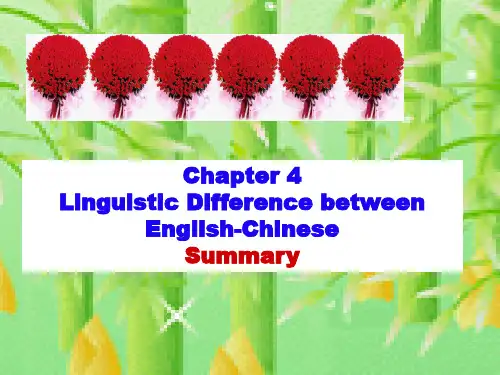

Chapter 4 A Comparative Study of English and Chinese (Part II) Teaching aims: to learn about the linguistic differences of Chinese and English so as to translate them accurately.Main Language points:Comparative studies of syntactic structure in Chinese and EnglishDifficult teaching points: hypotactic & paratactic; subject-prominent & topic prominent; static & dynamic.Teaching references:1. 方梦之. 翻译新论与实践[M]. 青岛出版社,20022. 孙致礼. 新编英汉翻译教程[M]. 上外教出版社;彭长江. 英汉-汉英翻译教程[M]. 湖南师大出版社;3. 陈宏薇,新编汉英翻译教程[M].上海外语教育出版社,2004Teaching methods: Analysis and Practice1. Hypotactic vs. Paratactic (形合与意合)As E. A. Nida points out in his “Translating Meaning”, …so fa r as English and Chinese are concerned, the most important difference linguistically is the contrast between hypotaxis and parataxis.Hypotaxis: The dependent or subordinate construction or relationship of clauses arranged with connectives;Parataxis: The arranging of clauses one after the other without connectives showing the relation between them;Examples:1. That is our policy and that is our declaration.—— W. Churchill这就是我们的国策。
第四章英汉语言对比与翻译Fiona Ma April, 201221. 英汉语言特点2. 英汉语言特点对 翻译的启示3. 课堂互动及课后练习英汉语言对比与翻译1.英语重形合,汉语重意合2.英语偏静态,汉语偏动态3.英语重抽象,汉语重具体4.英语重物称,汉语重人称5.英语重被动,汉语重主动6.英语多替换,汉语多重复7.英语重后饰,汉语重前饰8.英语重聚焦,汉语重流散9.英语重时体,汉语轻时体1. 英汉语言特点返回章重点 4例1: Children will play with dolls equipped withpersonality chips, computers with in-built personalities will be regarded as workmates rather than tools, relaxation will be in front of smell television, and digital age will have arrived.【译文】儿童将与装有个性芯片的玩具娃娃玩耍,具有个性内置的计算机将被视为工作伙伴儿不是工具,人们将在气味电视前休闲,这时数字时代就来到了。
例2: 早知今日,何必当初?【译文】If I had known it would have come to this, I would have acted differently.1.1 英语重形合,汉语重意合1. 英汉语言特点返回章重点 5例3: As we lived near the road, we oftenhad the traveler or stranger visit us to taste our gooseberry wine, for which we had great reputation, and I confess, with the veracity of an historian that I never knew one of them to find fault with it.【译文】我们就住在路边。